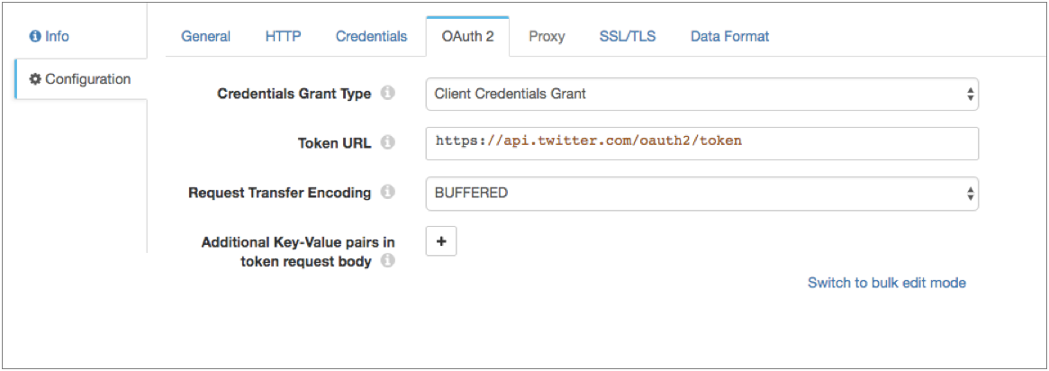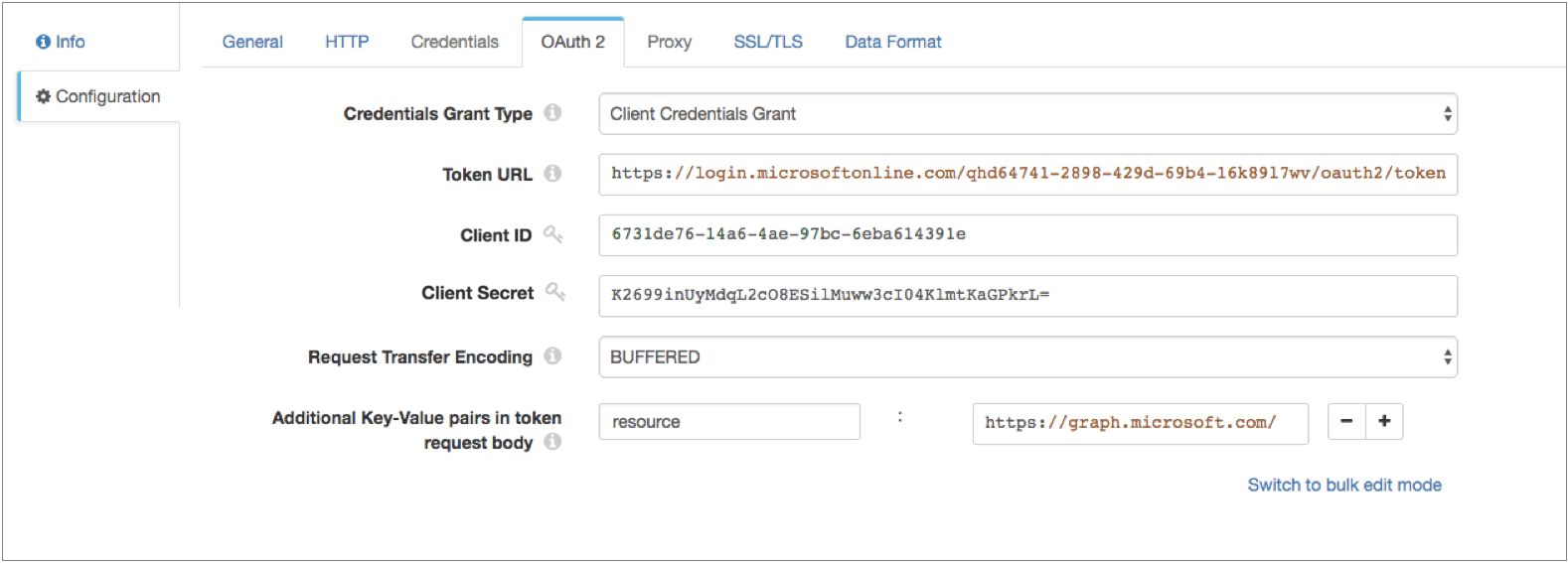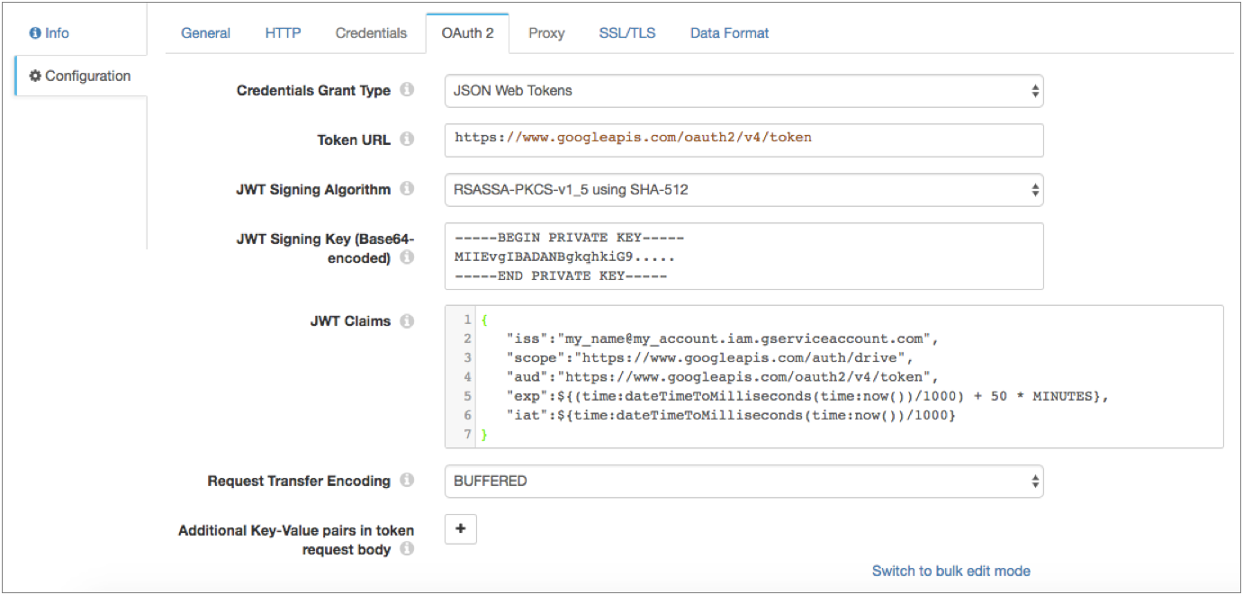HTTP Client
The HTTP Client processor sends requests to an HTTP resource URL and writes the results to a field in the record. You can use the HTTP Client processor to perform a range of standard requests or you can use an expression to determine the request for each record.
When you configure the HTTP Client, you define the resource URL, header attributes, and method to use. For some methods, you can specify the request body and default content type.
You can configure the processor to include response header fields in the record as a set of record header attributes or as a map in a record field. You can configure the processor to log request and response information. And you can write the resolved request URL to the Data Collector log.
You can also configure the timeout, request transfer encoding, maximum number of parallel requests, and authentication type. You can optionally use an HTTP proxy and configure SSL/TLS properties.
You can also configure the processor to use the OAuth 2 protocol to connect to an HTTP service.
HTTP Method
- GET
- PUT
- POST
- DELETE
- HEAD
- PATCH
- Expression - An expression that evaluates to one of the other methods.
Expression Method
The Expression method allows you to write an expression that evaluates to a standard HTTP method. Use the Expression method to generate a workflow. For example, you can use an expression that performs a lookup (GET) or passes data to the server (PUT) based on the data in a field.
Parallel Requests
The HTTP Client processor sends multiple requests at a time. To preserve record order, the processor waits until all requests for the entire batch are completed before processing the next batch.
You can specify the maximum number of parallel requests. Default is 1. Increasing the number of parallel requests can improve performance but increases the load on the server. Network latency can also significantly impact the performance of this processor.
OAuth 2 Authorization
You can configure the HTTP Client processor to use the OAuth 2 protocol to connect to an HTTP service that uses basic, digest, or universal authentication, OAuth 2 client credentials, OAuth 2 username and password, or OAuth 2 JSON Web Tokens (JWT).
The OAuth 2 protocol authorizes third-party access to HTTP service resources without sharing credentials. The HTTP Client processor uses credentials to request an access token from the service. The service returns the token to the processor, and then the processor includes the token in a header in each request to the resource URL.
- Client credentials grant
-
HTTP Client sends its own credentials - the client ID and client secret or the basic, digest, or universal authentication credentials - to the HTTP service. For example, use the client credentials grant to process data from the Twitter API or from the Microsoft Azure Active Directory (Azure AD) API.
For more information about the client credentials grant, see https://tools.ietf.org/html/rfc6749#section-4.4.
- Resource owner password credentials grant
-
HTTP Client sends the credentials for the resource owner - the resource owner username and password - to the HTTP service. Or, you can use this grant type to migrate existing clients using basic, digest, or universal authentication to OAuth 2 by converting the stored credentials to an access token.
For example, use this grant to process data from the Getty Images API. For more information about using OAuth 2 to connect to the Getty Images API, see http://developers.gettyimages.com/api/docs/v3/oauth2.html.
For more information about the resource owner password credentials grant, see https://tools.ietf.org/html/rfc6749#section-4.3.
- JSON Web Tokens (JWT)
-
HTTP Client sends a JSON-based security token encoding to the HTTP service. For example, use JSON Web Tokens to process data from the Google API.
Let’s look at some examples of how to configure authentication and OAuth 2 authorization to process data from Twitter, Microsoft Azure AD, and Google APIs.
Example for Twitter
To use OAuth 2 authorization to read from Twitter, configure HTTP Client to use basic authentication and the client credentials grant.
For more information about configuring OAuth 2 authorization for Twitter, see https://dev.twitter.com/oauth/application-only.

Example for Microsoft Azure AD
To use OAuth 2 authorization to read from Microsoft Azure AD, configure HTTP Client to use no authentication and the client credentials grant.
For more information about configuring OAuth 2 authorization for Microsoft Azure AD, see https://docs.microsoft.com/en-us/azure/active-directory/develop/active-directory-protocols-oauth-code.

Example for Google
To use OAuth 2 authorization to read from Google service accounts, configure HTTP Client to use no authentication and the JSON Web Tokens grant.
For more information about configuring OAuth 2 authorization for Google, see https://developers.google.com/identity/protocols/OAuth2.

Generated Records
The HTTP Client processor generates records based on the responses it receives.
Data in the response body is parsed based on the selected data format. For HEAD responses, when the response body contains no data, the processor creates an empty record. Information returned from the HEAD appear in record header attributes. For all other methods, when the response body contains no data, no records are created.
Including Response Headers
- Record header attributes
- The processor writes data in response headers to corresponding record header attributes.
- Record field
- The processor can also write the response headers to a field in the record. The processor writes the response headers to the record field as a map of key-value pairs where the key is the response header name.
Logging Request and Response Data
The HTTP Client processor can log request and response data to the Data Collector log.
When enabling logging, you configure the following properties:
- Verbosity
-
The type of data to include in logged messages:
- Headers_Only - Includes request and response headers.
- Payload_Text - Includes request and response headers as well as any text payloads.
- Payload_Any - Includes request and response headers and the payload, regardless of type.
- Log Level
- The level of messages to include in the Data Collector log. When you select a level, higher level messages are also logged. That is, if you select the Warning log level, then Severe and Warning messages are written to the Data Collector log.
- Maximum entity size
-
The maximum size of message data to write to the log. Use to limit the volume of data written to the Data Collector log for any single message.
Logging the Resolved Resource URL
You can write the resolved resource URL to the Data Collector log.
The resolved resource URL is the URL that is defined in the Resource URL property after resolving any expressions included in the URL.
https://api.twitter.com/1.1/search/tweets.json?q=${record:value('/text')}%23DataOps in the /text field, then the resolved URL
is:https://api.twitter.com/1.1/search/tweets.json?q=%23DataOpsTo write the resolved resource URL to the Data Collector log, set the Data Collector log level to DEBUG or higher. You do not need to use the Enable Request Logging property in the processor to log the resolved resource URL.
Data Formats
The HTTP Client processor writes the server response to the specified field in the record.
The processor treats the response as the specified data format and processes data differently based on the data format:
- JSON
- Writes a parsed JSON response to the specified field.
- Text
- Writes the response as a string to the specified field.
- XML
- Writes the XML response to the specified field.
Configuring HTTP Client Processor
Configure an HTTP Client processor to perform requests against a resource URL.